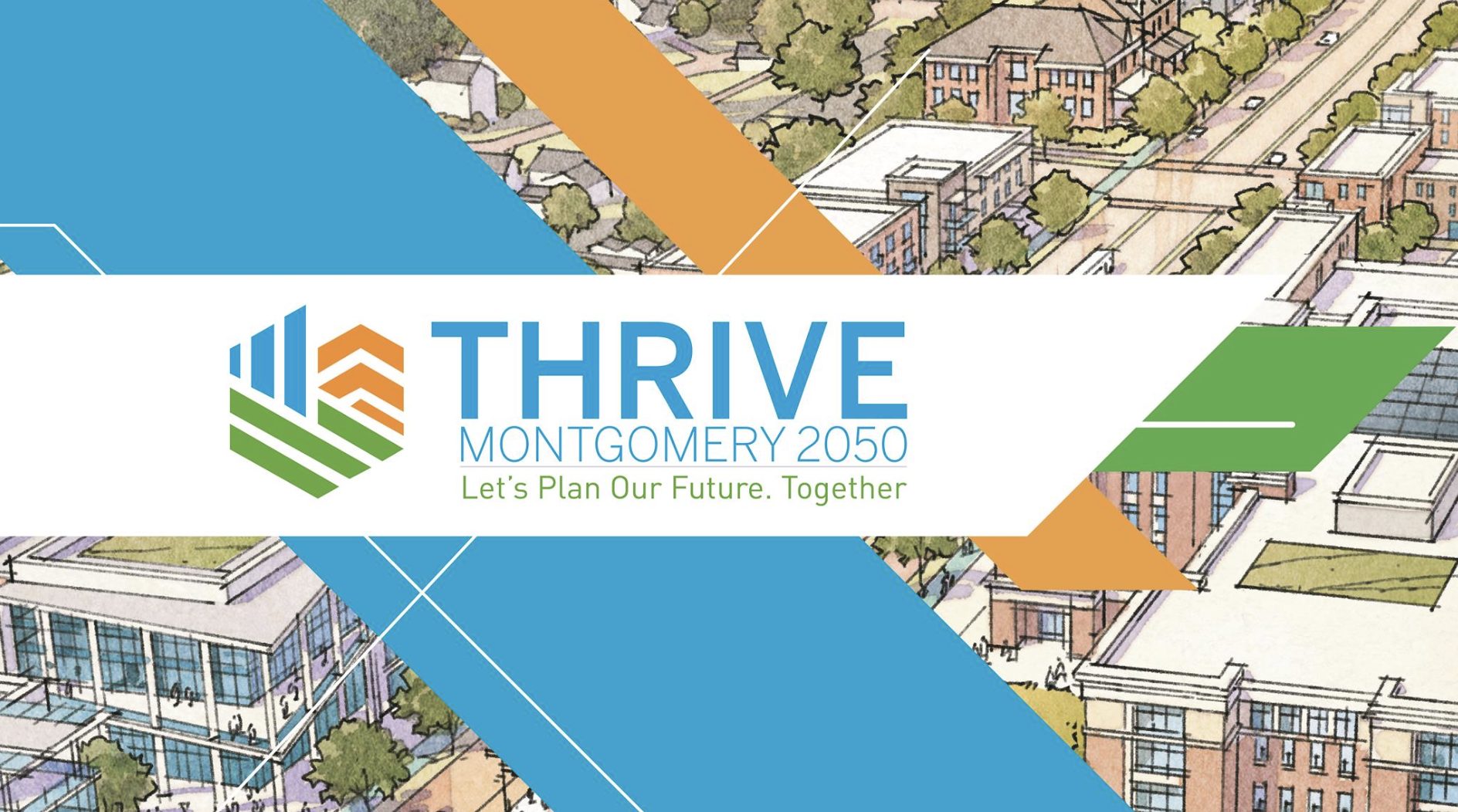
Update to the county’s General Plan includes bold recommendations to achieve outcomes of economic health, community equity, and environmental resilience; County Council Public Hearing expected this summer
WHEATON, MD – The Montgomery County Planning Board, part of The Maryland-National Capital Park and Planning Commission (M-NCPPC), voted to transmit the Planning Board Draft of the update to the county’s General Plan, known as Thrive Montgomery 2050, to the County Executive and the County Council on Thursday, April 8. Thrive Montgomery 2050 comprehensively updates the 1964 General Plan which has guided growth and development in the county for the last 60 years. Thrive Montgomery 2050 builds on the successes of the past and updates the county’s long-term framework for land use and development by envisioning a more economically competitive, environmentally sustainable, and more racially and socially equitable county over the next 30 years. It emphasizes maximizing the efficiency of the county’s land, creating a diversity of building types and design, and establishing complementary transportation infrastructure.
View the Thrive Montgomery 2050 Planning Board Draft
Thrive Montgomery 2050 sets a vision for the county and encompasses broad, county-wide policy recommendations for land use, housing, the economy, equity, transportation, parks and open space, and the environment. These recommendations provide guidance for future master plans, county and state capital improvement processes, and other public and private initiatives that influence land use and planning in the county.
The next steps for Thrive Montgomery 2050 will include a County Council public hearing that is anticipated in early summer where the community will be invited to testify. This will be followed by a series of work sessions and a vote on the Thrive Montgomery 2050 plan by the Council. Learn more at the County Council website. The last step is adoption of the final Thrive Montgomery 2050 plan by the Maryland-National Capital Park and Planning Commission.
“Montgomery County is facing a housing crisis, the effects of climate change, slow business growth, and growing awareness of racial and social inequities,” said Planning Board Chair Casey Anderson. “Thrive Montgomery establishes a framework for applying the tools of land use and transportation planning to help address these critical issues and using growth to improve our quality of life. This is the first complete overhaul of our community’s comprehensive plan since 1964, so it represents a chance to reconsider fundamental assumptions not simply about the regulation of development but about the nature of planning and what its objectives should be.”
Montgomery County’s population is projected to grow by approximately 200,000 people over the next 30 years, but nearly 85 percent of the county’s land is already developed or otherwise constrained. To help the county support this population increase, Thrive Montgomery 2050 recommends concentrating growth within intensively developed centers of activity along major roads and transit corridors. This strategy will direct population and employment growth to locations best served by infrastructure, services and amenities – including transit. It will also help create more sustainable, equitable, and complete communities.
“After working on Thrive Montgomery 2050 for nearly three years, we are proud of what we are presenting to the County Council and the County Executive,” said Montgomery Planning Director Gwen Wright. “This has truly been a collaborative effort with immense public input from the community. We want to thank everyone who has helped with this effort so far to create a vibrant vision for the future of Montgomery County.”
Since officially kicking off the public outreach for Thrive Montgomery 2050 in June 2019, Planning staff have held 166 meetings with the community to hear their ideas and feedback. During the COVID-19 pandemic, Planning staff adapted engagement efforts to virtual platforms, offering 13 events such as Ask Me Anything virtual townhalls and Thrive Montgomery 2050 Virtual Community Chats. The Planning Board received comments from 85 residents who testified at the Board’s public hearing on the Thrive Montgomery Public Hearing Draft Plan last November. Prior to finalizing the Planning Board Draft Plan, the Board held 10 public work sessions on the draft plan between December 2020 and March 2021 that focused on each chapter and provided opportunities before each session for community members to submit their written testimony on the policy recommendations.
Today also marked the launch of a new 12-part blog series on Thrive Montgomery 2050 written by Chair Anderson on Montgomery Planning’s Third Place Blog called Thrive Explained. The first article of the series was posted today on how the Planning Board Draft’s primary goals contrast with the 1964 General Plan. Subsequent posts will cover key topics such as the plan’s recommendations on housing, transportation, parks and recreation, and complete communities.
The County Council Public Hearing is anticipated to be scheduled in early summer. More information will be posted on the County Council website.
View the Thrive Montgomery 2050 Planning Board Draft
View the Thrive Montgomery 2050 Planning Board Draft Recommended Actions and List of References
View the Thrive Montgomery 2050 webpage
About Thrive Montgomery 2050
During summer 2019, the Montgomery County Planning Department launched the update of Montgomery County’s General Plan, the county’s long-term framework for land use and development. This effort, called Thrive Montgomery 2050, will result in new countywide policies to help Montgomery County thrive in the decades to come by addressing challenges and opportunities. A lot has changed in the county since the General Plan was originally approved in 1964. Thrive Montgomery 2050 will guide future growth in response to the demographic shifts, technological innovations, changing lifestyles and economic disruptions that have taken place in recent decades. The new General Plan will consider many issues framed by three pillars: economic health, environmental resilience and equity. This framework will help guide the recommendations of the plan with input from the community.